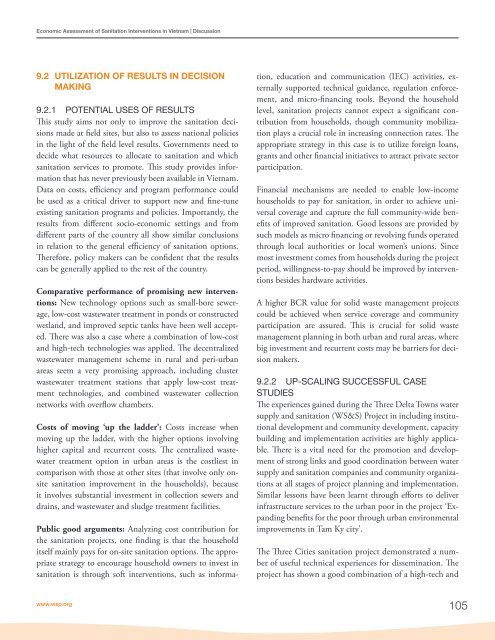Economic Assessment of Sanitation Interventions in Vietnam - WSP
Economic Assessment of Sanitation Interventions in Vietnam - WSP
Economic Assessment of Sanitation Interventions in Vietnam - WSP
You also want an ePaper? Increase the reach of your titles
YUMPU automatically turns print PDFs into web optimized ePapers that Google loves.
<strong>Economic</strong> <strong>Assessment</strong> <strong>of</strong> <strong>Sanitation</strong> <strong>Interventions</strong> <strong>in</strong> <strong>Vietnam</strong> | Discussion9.2 UTILIZATION OF RESULTS IN DECISIONMAKING9.2.1 POTENTIAL USES OF RESULTSThis study aims not only to improve the sanitation decisionsmade at field sites, but also to assess national policies<strong>in</strong> the light <strong>of</strong> the field level results. Governments need todecide what resources to allocate to sanitation and whichsanitation services to promote. This study provides <strong>in</strong>formationthat has never previously been available <strong>in</strong> <strong>Vietnam</strong>.Data on costs, efficiency and program performance couldbe used as a critical driver to support new and f<strong>in</strong>e-tuneexist<strong>in</strong>g sanitation programs and policies. Importantly, theresults from different socio-economic sett<strong>in</strong>gs and fromdifferent parts <strong>of</strong> the country all show similar conclusions<strong>in</strong> relation to the general efficiency <strong>of</strong> sanitation options.Therefore, policy makers can be confident that the resultscan be generally applied to the rest <strong>of</strong> the country.Comparative performance <strong>of</strong> promis<strong>in</strong>g new <strong>in</strong>terventions:New technology options such as small-bore sewerage,low-cost wastewater treatment <strong>in</strong> ponds or constructedwetland, and improved septic tanks have been well accepted.There was also a case where a comb<strong>in</strong>ation <strong>of</strong> low-costand high-tech technologies was applied. The decentralizedwastewater management scheme <strong>in</strong> rural and peri-urbanareas seem a very promis<strong>in</strong>g approach, <strong>in</strong>clud<strong>in</strong>g clusterwastewater treatment stations that apply low-cost treatmenttechnologies, and comb<strong>in</strong>ed wastewater collectionnetworks with overflow chambers.Costs <strong>of</strong> mov<strong>in</strong>g ‘up the ladder’: Costs <strong>in</strong>crease whenmov<strong>in</strong>g up the ladder, with the higher options <strong>in</strong>volv<strong>in</strong>ghigher capital and recurrent costs. The centralized wastewatertreatment option <strong>in</strong> urban areas is the costliest <strong>in</strong>comparison with those at other sites (that <strong>in</strong>volve only onsitesanitation improvement <strong>in</strong> the households), becauseit <strong>in</strong>volves substantial <strong>in</strong>vestment <strong>in</strong> collection sewers anddra<strong>in</strong>s, and wastewater and sludge treatment facilities.Public good arguments: Analyz<strong>in</strong>g cost contribution forthe sanitation projects, one f<strong>in</strong>d<strong>in</strong>g is that the householditself ma<strong>in</strong>ly pays for on-site sanitation options. The appropriatestrategy to encourage household owners to <strong>in</strong>vest <strong>in</strong>sanitation is through s<strong>of</strong>t <strong>in</strong>terventions, such as <strong>in</strong>formation,education and communication (IEC) activities, externallysupported technical guidance, regulation enforcement,and micro-f<strong>in</strong>anc<strong>in</strong>g tools. Beyond the householdlevel, sanitation projects cannot expect a significant contributionfrom households, though community mobilizationplays a crucial role <strong>in</strong> <strong>in</strong>creas<strong>in</strong>g connection rates. Theappropriate strategy <strong>in</strong> this case is to utilize foreign loans,grants and other f<strong>in</strong>ancial <strong>in</strong>itiatives to attract private sectorparticipation.F<strong>in</strong>ancial mechanisms are needed to enable low-<strong>in</strong>comehouseholds to pay for sanitation, <strong>in</strong> order to achieve universalcoverage and capture the full community-wide benefits<strong>of</strong> improved sanitation. Good lessons are provided bysuch models as micro f<strong>in</strong>anc<strong>in</strong>g or revolv<strong>in</strong>g funds operatedthrough local authorities or local women’s unions. S<strong>in</strong>cemost <strong>in</strong>vestment comes from households dur<strong>in</strong>g the projectperiod, will<strong>in</strong>gness-to-pay should be improved by <strong>in</strong>terventionsbesides hardware activities.A higher BCR value for solid waste management projectscould be achieved when service coverage and communityparticipation are assured. This is crucial for solid wastemanagement plann<strong>in</strong>g <strong>in</strong> both urban and rural areas, wherebig <strong>in</strong>vestment and recurrent costs may be barriers for decisionmakers.9.2.2 UP-SCALING SUCCESSFUL CASESTUDIESThe experiences ga<strong>in</strong>ed dur<strong>in</strong>g the Three Delta Towns watersupply and sanitation (WS&S) Project <strong>in</strong> <strong>in</strong>clud<strong>in</strong>g <strong>in</strong>stitutionaldevelopment and community development, capacitybuild<strong>in</strong>g and implementation activities are highly applicable.There is a vital need for the promotion and development<strong>of</strong> strong l<strong>in</strong>ks and good coord<strong>in</strong>ation between watersupply and sanitation companies and community organizationsat all stages <strong>of</strong> project plann<strong>in</strong>g and implementation.Similar lessons have been learnt through efforts to deliver<strong>in</strong>frastructure services to the urban poor <strong>in</strong> the project ‘Expand<strong>in</strong>gbenefits for the poor through urban environmentalimprovements <strong>in</strong> Tam Ky city’.The Three Cities sanitation project demonstrated a number<strong>of</strong> useful technical experiences for dissem<strong>in</strong>ation. Theproject has shown a good comb<strong>in</strong>ation <strong>of</strong> a high-tech andwww.wsp.org105
















